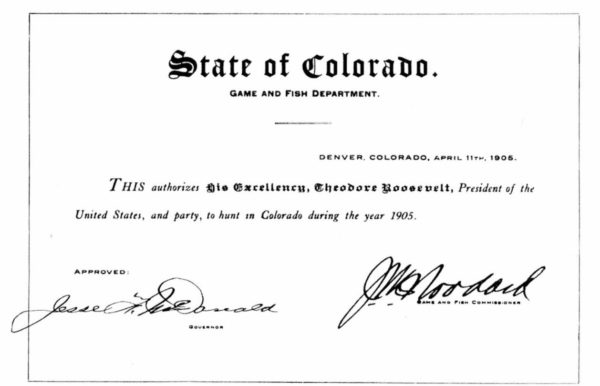
Colorado’s efforts to preserve its natural resources are nothing new. As long as Colorado has been a state, there has been a state agency tasked with protection of Colorado’s game, fish, and parks. The name has changed over the years, and the agency has evolved – but its core mission of protecting Colorado’s incredible wildlife and natural beauty has remained unchanged.
Colorado’s first wildlife protection laws, “To provide for the Protection of Fish in Colorado Territory” and “To preserve Game in Colorado,” were passed on February 11, 1870. Colorado was granted statehood in 1876, and the very first General Assembly after statehood, in 1877, created the position of State Fish Commissioner. In 1893 this role was expanded to become the State Game and Fish Warden. Biennial reports from 1881 to 1896 have been digitized and are available online from the State Publications Library.

At the turn of the twentieth century, as industry and population expanded, America was no longer the agrarian nation that the founders knew. More and more wilderness was being lost to mining, logging, the expansion of railroads, newer and bigger cities, and even tourism. Led by conservationists like John Muir and President Theodore Roosevelt, Americans were beginning to embrace the cause of protecting natural resources. Numerous National Parks and Monuments were designated during this period. But people also began to see that it was not only the scenery that needed protection, but that fish, birds, and other wildlife were in danger, too. In 1899, Colorado expanded its state wildlife agency to become the full-fledged Department of Forestry, Game and Fish; two years later, the forestry aspect was removed and the agency became simply the Department of Game and Fish, its sole mission “to protect game and fish.” The department continued to be led by a State Game and Fish Commissioner, whose biennial reports from this period are also available online.

The agency accomplished much during this period. In 1899 Colorado began requiring licenses for hunting and fishing. A number of fish hatcheries were also established during the early part of the century. In the 1940s, famed naturalist Arthur Carhart undertook several wildlife surveys for the Department, now in the collection of the State Publications Library, and many other studies and reports were completed as well.
In 1963 the duties of the Parks and Recreation Board were combined with Game and Fish, creating the new Department of Game, Fish and Parks. Five years later the Executive branch of state government was reorganized, and a new Department of Natural Resources was established. Game, Fish and Parks now became a division within the new department, which would also oversee water resources, soil conservation, oil and gas, mines, and geology.
More changes came in 1972, when the Game, Fish and Parks Division was split into the Division of Wildlife and the Division of Parks and Outdoor Recreation. The new name reflected the agency’s interest in protecting and studying all kinds of wildlife, not just those associated with hunting and fishing. Finally, in 2011 the two divisions were reunited, becoming today’s Colorado Parks and Wildlife.
The State Publications Library offers access to hundreds of publications from Colorado’s parks and wildlife agencies through the years. These include a full run of their magazine Colorado Outdoors, which first began publication more than sixty years ago; a variety of wildlife guides and brochures; hunting and fishing information; and much more. A history of the agency up to 1972 can be found in A Look Back: A 75-Year History of the Colorado Game, Fish and Parks Division.

- How to Spot the Differences Between Eagles and Hawks - August 16, 2021
- How Transportation Projects Help Tell the Story of Colorado’s Past - August 9, 2021
- Time Machine Tuesday: The Night the Castlewood Canyon Dam Gave Way - August 3, 2021